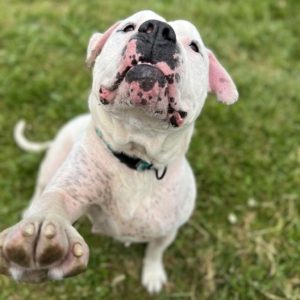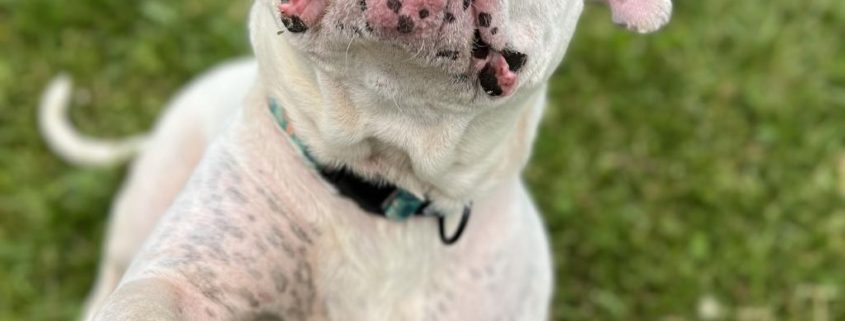Ask Crystal: Nail Trimming Issues

Dear Crystal,
My Rotty will not let me cut his nails. It is affecting his walking ..so he doesn’t want to walk. He’s struggling to walk…I’m disabled and don’t have the money to get his rabies shot and worming, and nails. I cut one too much so now he will not let me cut them.
Thanks,
Nail trims are scary
Dear Nail,
It is a very common issue for dogs to not like their nails being cut. One theory is that it goes back to protecting their legs in the wild. When one dog is trying to kill or seriously injure another dog, they often disable the legs first so the dog cannot flee. It makes sense then that dog might be wary of someone grabbing their paw, holding it, and then cutting nails. Most people don’t work on slowly acclimating the dog to having paws handled.
You must first get your dog completely comfortable with having his feet handled before you can proceed to actually cut his nails. Usually, I recommend having someone else cut the dog’s nails while you are working on it. That way he doesn’t associate it with you and someone else can be the bad guy. He may need some short-term behavioral medication to get him through as well. I know finances are tight for you. Many counties offer low-cost vaccinations or wellness clinics, they may also offer nail trims with that. Check with your local humane society and they should be able to direct you to the resources.
- Let’s start with getting the dog used to his paws being handled. I would suggest that you work on this daily until you have a dog that is comfortable with paw handling. I usually do a short training session before dinner with my dogs to work on this. We usually do no more than a 10-minute session daily.
- We start the training at a place where the dog is comfortable being touched. This might be his shoulder or somewhere at the top of his leg. We refer to this as below threshold. Threshold is where the dog starts to react in a fearful or aggressive manner. Dogs cannot learn in that state of mind so we must work with them before they reach that. We don’t want him to be growling or pulling away. This is not about forcing the dog but about changing his opinion about this type of touch.
- Touch him at that spot and when he notices your touch, start feeding him bits of chicken or other high value. Only touch the spot for a couple of seconds. As soon as you stop touching, stop feeding treats. Repeat until your touch consistently leads to your dog looking happily to you as if to say, “Where are my treats?”. This is what we call a CER, which means a Conditioned Emotional Response. This is how we change emotional responses. When your dog offers a CER, you know he is getting that association of touch means yummy treats. At that point, you can move a little down the leg and repeat the process.
- Next you can work on increase the duration of the touch up to 4 seconds, then 8 seconds and then up to 10 seconds. Work your way down his leg always working towards getting that CER reaction.
- Then, you can work on the amount of pressure of your touch. Start back up at the top of the leg and touch the spot with more pressure. Slide your hand a little further down and touch with more pressure down the leg. Continue with your repetitions until you can get a consistent CER in each new location. Gradually work your way down the dog’s leg down to his paw.
- When you are able to get to the paw, touch for a long duration and add pressure, you can work on briefly lifting the dog’s paw up. Lift the paw up just a little at first and then more and more as he gets used to it. Once you are able to lift up the paw for a duration with pressure with a happy CER from him, you can move on to the other legs and repeat all the steps.
- Now that the dog is happily accepting of his paws being handled, you can move on to the acclimation to the clipper or if you want to use a nail grinder. A nail grinder can be a better idea for a dog with very long nails as it is easier to keep from cutting the quick. You do have to get the dog used to the sound and vibrations of the grinder.
- Whether you use a grinder or a clipper, you will repeat the process with the tool in your hand. Show the tool and treat. Place behind your back and keep showing it to the dog and treating. Next touch the tool to a nail and treat. Slowly increase the amount of time that the tool is touching the nail. Note that the grinder is not on at this point. Next either condition the sound of the grinder or the clip of the clipper. Again, we want to start at a distance which the dog can tolerate and slowly move closer as you are achieving CERs at each step.
- You can then start touching with the grinder on or clip the clippers and then treat. Keep durations short and slowly build in duration. When you can hold his paw and hold the tool right next to his nail then you can quickly clip or grind a little off. I usually try to do one nail a day at first until I get through all of them. We don’t want to overwhelm the dog by trying to clip too many nails at one time.
The other thing that I have been doing is laying down a blanket and inviting the dog to lay on it. I pick up the paw and if the dog gets up or tries to pull their paw away, I let them. I want the dog’s permission and cooperation. I also want to respect when they are telling me that they don’t want to participate. That usually means either I haven’t done enough work to make it rewarding enough or they just aren’t feeling in the mood. By respecting our dog’s communication, we can usually avoid aggressive responses as they won’t feel the need to escalate their response.
Keep in mind that this is a series of behaviors and stimuli involved and if the dog has had multiple bad experiences or successfully used aggression, this will take longer to get where you want to be. It is absolutely worth the work as this is something that needs to be kept up for the dog’s entire life. It is bad for their paws to have long nails so it does need to get done regularly so for now have a professional cut them if you can so he can walk. It is also potentially painful for him to have his paws handled while his nails are so long which doesn’t help your training so it is worth trying to find someone to do it. Then you can be working on the training in the meantime.
Until next time,
Crystal
Submit your own pet behavior question for Crystal here:







